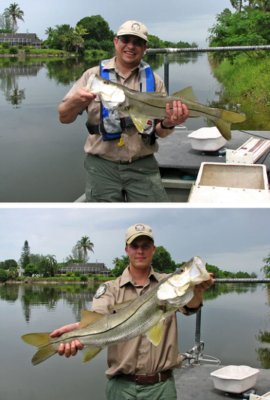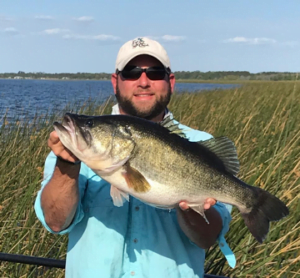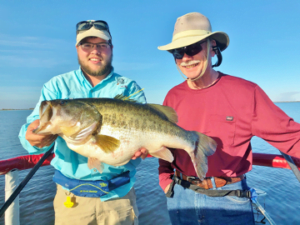As I stood there smiling and posing for the camera, I had no idea that the snook I was holding before me in my own two hands was busy changing my life. Hours after I released it, that fish would resurface to turn me from a life of honesty down a path of deception and glory-seeking from which I would never return.
It all began innocently enough as just another day in the life of a fisheries biologist. A coworker and I were conducting a fish population survey in a south Florida canal. It was business as usual — we were electrofishing largemouth bass, bluegill, redear sunfish and some of the exotic species like peacock bass and Mayan cichlid that make Florida fishing totally unique.
Then we dipnetted “The snook.” Saltwater visitors such as snook and tarpon can really spice up a bass fishing trip and are just one more factor that makes Florida fishing so special. Plop went The snook into the livewell, until twenty minutes later when it was time to “work up” this batch of fish. Pausing in our weighing and releasing, my colleague and I passed the camera around and grabbed a few photos of the day’s big catch. I was absolutely clueless as to what was actually happening to me in those brief moments.
The next day and back in the air conditioning, we reviewed our trip photos on the computer. I was startled to see that we had actually sampled two snook that day — the little tyke I was holding, and one twice that size being proudly displayed by my coworker. It took only a moment to dawn on me that, of course, the photos were both of the same fish!
As a fisheries biologist I had always held my fish, be it work or play, close to my body while being photographed for an accurate size representation. But that day as I gazed at my buddy’s photo, a transformation took place. In an instant, a man who once valued accuracy and objectivity decided he no longer cared about such trifles. No, what he really wanted were great fishing photos to post on Facebook, to email to his friends and to use as his computer wallpaper. And just like that, a liar was born.
Well, not really — fortunately! Now I do hold that fish out toward the camera, but along with a newfound photographer’s ethic, I’ve also come to appreciate fishing photography as an art form that surpasses the simple recording of the basic facts of a fishing trip. And I continue to believe that photos don’t lie, although they can certainly exaggerate.

What, you might ask, are my fish photo creds? Not only do I fish for bass as an angler, but I sample bass as a biologist, and have also chaired the submission approval team for FWC’s TrophyCatch program. The single required photo or video for a TrophyCatch submission is the entire fish visible on a scale, with the scale weight clearly legible. Beyond that, a wide array of photos are often included with the submissions, and it is absolutely astonishing how different the same fish can look from one photo to the next.
From all these experiences, I am here to tell you two things: one, it can be very hard to accurately estimate the weight of a fish from a photo. And two, no matter who you are or how experienced an angler (or fisheries biologist!), the stats show that you are not quite as good at it as you think you are. But I’m not asking you to believe me. I’m asking you to believe cold, hard numbers.

FWC’s TrophyCatch program recently presented anglers with a series of three “Eyeball Challenges.” Each Challenge asked anglers to estimate the weights of bass in a series of photos. Every bass had been weighed by a biologist with field scales to ensure accuracy. Nearly 900 anglers completed the final round, and the results were quite revealing: on average, anglers were off by plus or minus 2.22 pounds per bass. Even the top 5% of all guessers — the A-pluses at the head of the class — were only able to shave their error down to plus or minus 1.35 pounds of the actual weight.
 Furthermore, fishing experience has no effect on how good you are at the photo guessing game. There was no difference in weight accuracy between participants identifying themselves as novice, intermediate or avid anglers. Looking at reported years of experience, there was only one statistically significant result: You must fish for 60 years — call it a lifetime — to gain a paltry half-pound in weight-guessing accuracy. The bottom line is that no matter how good you are at catching fish or how long you’ve been fishing, a variety of factors makes it hard to accurately guess the weight of a fish from a photo.
Furthermore, fishing experience has no effect on how good you are at the photo guessing game. There was no difference in weight accuracy between participants identifying themselves as novice, intermediate or avid anglers. Looking at reported years of experience, there was only one statistically significant result: You must fish for 60 years — call it a lifetime — to gain a paltry half-pound in weight-guessing accuracy. The bottom line is that no matter how good you are at catching fish or how long you’ve been fishing, a variety of factors makes it hard to accurately guess the weight of a fish from a photo.

One of the biggest factors I’m sure you’ve already deduced: how you hold your fish for the camera makes a big difference in how that fish is perceived in the resulting photo. In order to scientifically test this variable, half of the bass featured in the Round 3 survey were held out toward the camera at arm’s length. The other half were all held much closer to the angler’s torso. Sure enough, there was a marked difference in weight-guessing between these two groups.
Anglers were much more accurate at guessing the weights of bass held at arm’s length. This makes sense, since all you need to do is browse a fishing magazine or a tournament Facebook page to see that the “hold-your-fish-out” pose is the industry standard. For fish held close to the body, anglers consistently underestimated those bass by more than 1.25 pounds on average.

Two particular Eyeball Challenge bass stymied anglers and demonstrated the difficulty of weighing a fish by eye rather conspicuously. The first bass pictured above weighed 12.4 pounds and was over 26 inches long. A whopping 96% of anglers guessed low, with the average guess being a paltry 8.7 pounds. It is worth noting that the biologist in the photo is well above average in size — yet another variable that might be tested in future Eyeball Challenges.
At the other extreme, the second bass shown below weighed 10 pounds even and was just over 23 inches long. This time an almost-identical 97% of anglers guessed high. What’s more, two-thirds thought this fish weighed more than 13 pounds. Clearly if size matters, then the way your hold your bass for the camera certainly matters, too.
So, there you have it: “It’s now scientifically proven — if you want the best photos of your catch, do hold that fish out toward the camera,” says biologist Drew Dutterer, who helped to design the study. “If not, it may be impossible to convince your fishing buddies just how big that bass really was!”
But as you pose for that photo, be careful. One of those fish might be changing your life.
by John Cimbaro

